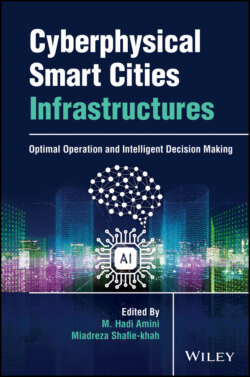Читать книгу Cyberphysical Smart Cities Infrastructures - Группа авторов - Страница 30
2.3.3.1 Traffic Decision‐Making System
ОглавлениеTraffic decision‐making system, as known as intelligent transportation system (ITS), aims to detect traffic flow within a smart city and offer optimal solutions using proper big data analytics [48]. Assessing and analyzing this big data plays a pivot role in decision making systems that makes the process time‐ and cost‐efficient [37]. Researchers addressed some case studies within traffic decision‐making systems, such as road traffic accidents analysis [49, 50], public transportation management and control, and road traffic flow prediction.
Challenges: In these such systems, users feed data into them by gathering data from heterogeneous resources, such as high‐performance IoT devices, video detectors, and GPS. The systems must use big data analysis approaches to evaluate the data online [51] to provide efficient and intimate knowledge for decision making. To be more certain about the amount of data these systems handle, consider Petabyte level data that are beyond the utmost of traditional machine learning analytic abilities [51]. This is due to two important issues: these traditional data processing algorithms are not yet developed for online and real‐time monitoring systems, and additionally, they fail to learn from these data due to disorganized and nonstandard structures.
Solutions: Smart cities, particularly in this domain (i.e. one of their important features, smart mobility, discussed in Figure 2.1), need optimum traffic decision‐making systems that address the aforementioned challenges and provide efficient solutions to them. One of the solutions discussed in [51] is the use of big data analytics approaches. They solved the challenges by providing enough data storage, analysis, and management tools. The most important and promising frameworks, libraries, or technologies are used to analyze the big data, such as Hadoop and Spark, but not limited to them. For instance, researchers in [52] established a time‐efficient and scalable distributed technique, namely, Partition‐Aware Connected Components (PACC), for connected component computation that relies on main approaches: edge filtering, two‐step processing of partitioning and computation, and sketching. PACC outperforms MapReduce and Spark frameworks and is time‐efficient on real‐world graphs [52].
Additionally, big data analysis algorithms facilitate and boost the process of handling large amount of data to provide enough information for making decisions. Traffic decision‐making systems using big data algorithms and technologies help associate offices and the people in charge to get to learn drivers' journey patterns within the transportation network that reports whole network trends or better understanding of similar drivers [37]. Considering this feature, the systems provide the best path to drivers to reach their destination through the minimum time possible. Furthermore, the systems help the city to relay the traffic by controlling traffic light, the best timing to decide which light should be on or off and for what period.
Furthermore, traffic decision‐making systems predicts the probability of traffic accident occurrence using big data algorithms [37]. This requires to have smart healthcare systems, which is nominated as one of smart cities features discussed in Figure 2.1, to help emergency centers to facilitate the process of emergency rescue.
